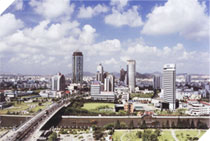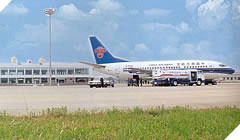Transportation
Jiangsu Transportation
 Transport and post and telecommunications have developed at high pace in the province. Jiangsu now has a comprehensive transport network of "rail,road,water,air and pipe". Post and telecommunications are also developing rapidly and the province has built up the communications network of cable,microwave,short-wave,satellite,optical-fiber cables,wireless telephones and data communications.
Transport and post and telecommunications have developed at high pace in the province. Jiangsu now has a comprehensive transport network of "rail,road,water,air and pipe". Post and telecommunications are also developing rapidly and the province has built up the communications network of cable,microwave,short-wave,satellite,optical-fiber cables,wireless telephones and data communications.
CONVENIENT RAIL TRANSPORTATION
The railways connect Jiangsu to over 40 big and midium-sized cities in China. Nanjing and Xuzhou are the two hubs of transportation in Jiangsu,possessing the three trunk national rail lines: Beijing-Shanghai,Nanjing-Wuhu,and Lianyungang- Urumqi. Jiangsu is building a railway network connecting all parts in the province,and the rails have already been laid. The new Eurasia Continental Bridge connecting Lianyungang as the eastern end with Rotterdam as the western end has taken up 95 % of the cross-border transport business since it was opened at the end of 1992. REMARKABLE HIGHWAY CONSTRUCTION
REMARKABLE HIGHWAY CONSTRUCTION
The Shanghai-Nanjing expressway seems to bring the two cities closer. The general quality of the Shanghai-Nanjing expressway and the new Nanjing airport expressway are among the highest in the country. By the end of 2002,a highway network,with Nanjing at its center,had been formed,which reaches all cities,counties,towns and villages in the province. The trunk highways consist of expressways,first-and second-class highways which all have connections with those in the neighbouring provinces. The total mileage of the expressways in Jiangsu exceeded 1,702 km in 2002.
ACCELERATED CONSTRUCTION OF CROSS-YANGTSE PASSAGES
The Second Nanjing Yangtse River Bridge,which was designed,constructed and supervised by China exclusively was open to traffic at the end of March 2002. It is the third cross-Yangtse bridge in the Jiangsu part.
As the middle and lower reaches of the Yangtse River cross Jiangsu,cross-Yangtse bridges become important to communications between two sides of the Yangtse River. The cross-Yangtse bridges in Jiangsu have different features. The Nanjing Yangtse River Bridges is a double-deck railway and highway bridge,which China designed and constructed completely by itself in the 1960s. The Jiangyin Yangtse River Highway Bridge,which was open to traffic in October 1999,is the longest suspension bridge in China and the 4th longest in the world. The Second Nanjing Yangtse River Bridge is 21.197 km long. Its main span is 628 metres,the longest of its kind in the country and the third longest in the world. A further Runyang Yangtse River Bridge is under construction.
INTERNATIONAL ROLE OF NANJING AIRPORT Najing Lukou International Airport is a key airport for passengers in China and for freight transport in East China. It now has 67 domestic and international flights. All the giant airliners can land and take off here. People can now fly from Nanjing to Hongkong,Macao,Taibei and Gaoxiong (via Macao),and there are also charter flights to Kuala Lumpur,Bangkok,Nagoya and Seoul. International freight flights connecting Nanjing to Winnipeg and Moscow is also in service. In addition ,seven other cities in Jiangsu have their own civil airports. The domestic flights can reach all major cities in China,while their links with international flights enable Jiangsu to reach the USA,West Europe and Africa.
Najing Lukou International Airport is a key airport for passengers in China and for freight transport in East China. It now has 67 domestic and international flights. All the giant airliners can land and take off here. People can now fly from Nanjing to Hongkong,Macao,Taibei and Gaoxiong (via Macao),and there are also charter flights to Kuala Lumpur,Bangkok,Nagoya and Seoul. International freight flights connecting Nanjing to Winnipeg and Moscow is also in service. In addition ,seven other cities in Jiangsu have their own civil airports. The domestic flights can reach all major cities in China,while their links with international flights enable Jiangsu to reach the USA,West Europe and Africa.
PORTS ALONG THE COAST AND THE YANGTSE RIVER
There are 11 state-approved first class open ports in Jiangsu like Lianyungang Port,Nanjing Port and Nantong Port,which have 128 berths above 10,000 tonnage level and an annual handling capacity of 425 million tons. Lianyungang Port,one of the most important seaports in China,provides the most convenient and economic port for northwestern and central China. Nanjing Port is the largest inland port in Asia with a total handling capacity of more than 60 million tons per year. It has been linked with 160 ports in 76 countries and regions.
THE LONGEST WATERWAY IN CHINA
Jiangsu enjoys a special geographical advantage in inland water transport. The Yangtse River runs across the province from west to east for 400 km. The section eastward from Nanjing can accommodate oceangoing vessels of 50 thousand tons. The Grand Canal flows from north to south for over 690 km. Jiangsu is now completely open to navigation. There are more than 2,200 waterways throughout the province with a total navigable length of 23,800 kilometers,with both numbers taking the first place in China.
POST AND TELECOMMUNICATIONS RANKING SECOND IN CHINA Jiangsu has built up a communication network of fiber-optic cable supported by digital microwave transmission. Jiangsu has succeeded in spreading digital exchanges to areas above township level with all communications digitised. Mobile telephones can reach the whole province and roam throughout the country. Digital and multi-media communications have come into practice. Postal Green Cards,EMS,mailed advertisements and flower telegrams have become popular in the province. The comprehensive telecommunication capacity in Jiangsu takes the second place in the country. Jiangsu was the first province in China to extend telephone lines to all villages. The total capacity of the provincial telephone exchanges in 2002 reached 21,748,000,with 16,600,000 fixed telephones and 14,876,000 mobile telephones. About 42.6 % of the provincial population have become telephone subscribers.
Jiangsu has built up a communication network of fiber-optic cable supported by digital microwave transmission. Jiangsu has succeeded in spreading digital exchanges to areas above township level with all communications digitised. Mobile telephones can reach the whole province and roam throughout the country. Digital and multi-media communications have come into practice. Postal Green Cards,EMS,mailed advertisements and flower telegrams have become popular in the province. The comprehensive telecommunication capacity in Jiangsu takes the second place in the country. Jiangsu was the first province in China to extend telephone lines to all villages. The total capacity of the provincial telephone exchanges in 2002 reached 21,748,000,with 16,600,000 fixed telephones and 14,876,000 mobile telephones. About 42.6 % of the provincial population have become telephone subscribers.
MODERN TELECOMMUNICATION NETWORK TAKING SHAPE
Advanced technology and information networks have been widely used in Jiangsu ,to name a few,public information networks,intellectual network,fiber optics inlet network,numerical synchronized network information management network and No.7 information order. The wide-band multi-media network of posts and telecommunication,known as the province's information expressway which integrates voice,data and wide-band visual pictures and texts,has been initiated to the fullest,providing services of long-distance medical treatment,education and VOD. The registered internet users rose to 3,929,000,showing an increase of 58.5 %.
EFFECTIVE WATERWORKS
Jiangsu has for the most part built up effective water conservancy projects against flood and draught and many flood-preventing projects and key water-source projects have gone into operation. Strong stone banks along the coast and the Yangtse River have become iron walls against sea tides and the Yangtse floods,playing important roles in economic development,social stability and improvement of people's livelihood.
RAPID CONSTRUCTION OF POWER PLANTS
With construction and renovation of urban and rural power grid,there is enough power supply now and every village in the province has access to electricity. The Lianyungang Tianwan Nuclear Power Plant,which is now under construction,is to be the largest of its kind in China. The two units of nuclear power generators will start operation in 2004 and 2005 respectively. The annual electricity output of the power plant will be over 14 billion kwh when completed in 2005.